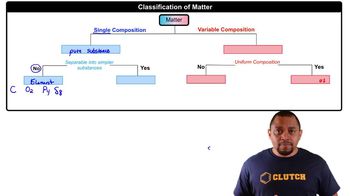Predict the products and write a balanced molecular equation for each reaction. If no reaction occurs, write 'NO REACTION.' b. Cr(NO3)3(aq) + LiOH(aq) →
Ch.4 - Chemical Quantities & Aqueous Reactions
Chapter 4, Problem 113
Hard water often contains dissolved Ca2+ and Mg2+ ions. One way to soften water is to add phosphates. The phosphate ion forms insoluble precipitates with calcium and magnesium ions, removing them from solution. A solution is 0.050 M in calcium chloride and 0.085 M in magnesium nitrate. What mass of sodium phosphate would you add to 1.5 L of this solution to completely eliminate the hard water ions? Assume complete reaction.
 Verified step by step guidance
Verified step by step guidance1
Identify the chemical reactions involved: \( \text{Ca}^{2+} + \text{PO}_4^{3-} \rightarrow \text{Ca}_3(\text{PO}_4)_2 \) and \( \text{Mg}^{2+} + \text{PO}_4^{3-} \rightarrow \text{Mg}_3(\text{PO}_4)_2 \).
Calculate the moles of \( \text{Ca}^{2+} \) in the solution: \( 0.050 \text{ M} \times 1.5 \text{ L} \).
Calculate the moles of \( \text{Mg}^{2+} \) in the solution: \( 0.085 \text{ M} \times 1.5 \text{ L} \).
Determine the moles of \( \text{PO}_4^{3-} \) needed to react with both \( \text{Ca}^{2+} \) and \( \text{Mg}^{2+} \) using stoichiometry from the balanced equations.
Calculate the mass of \( \text{Na}_3\text{PO}_4 \) required using the moles of \( \text{PO}_4^{3-} \) and the molar mass of \( \text{Na}_3\text{PO}_4 \).

Verified video answer for a similar problem:
This video solution was recommended by our tutors as helpful for the problem above.
Was this helpful?
Key Concepts
Here are the essential concepts you must grasp in order to answer the question correctly.
Hard Water Composition
Hard water is characterized by the presence of dissolved minerals, primarily calcium (Ca²⁺) and magnesium (Mg²⁺) ions. These ions can form insoluble compounds with certain anions, leading to the formation of scale in pipes and appliances. Understanding the concentration of these ions is crucial for determining how to treat hard water effectively.
Recommended video:
Guided course

Matter Composition
Precipitation Reactions
A precipitation reaction occurs when two soluble salts react to form an insoluble product, or precipitate. In this case, phosphates react with calcium and magnesium ions to form insoluble calcium phosphate and magnesium phosphate. This concept is essential for calculating the amount of sodium phosphate needed to remove hard water ions from the solution.
Recommended video:
Guided course

Selective Precipitation
Stoichiometry
Stoichiometry involves the calculation of reactants and products in chemical reactions based on balanced equations. It allows us to determine the exact amounts of substances needed for a complete reaction. In this scenario, stoichiometry is used to calculate the mass of sodium phosphate required to react with the given concentrations of calcium and magnesium ions in the solution.
Recommended video:
Guided course

Stoichiometry Concept
Related Practice
Textbook Question
2
views
Textbook Question
Predict the products and write a balanced molecular equation for each reaction. If no reaction occurs, write 'NO REACTION.' c. liquid pentanol (C5H12O) and gaseous oxygen
Textbook Question
An acid solution is 0.100 M in HCl and 0.200 M in H2SO4. What volume of a 0.150 M KOH solution would completely neutralize all the acid in 500.0 mL of this solution?
Textbook Question
Find the mass of barium metal (in grams) that must react with O2 to produce enough barium oxide to prepare 1.0 L of a 0.10 M solution of OH-.
Textbook Question
A solution contains Cr3+ ions and Mg2+ ions. The addition of 1.00 L of 1.51 M NaF solution causes the complete precipitation of these ions as CrF3(s) and MgF2(s). The total mass of the precipitate is 49.6 g. Find the mass of Cr3+ in the original solution.
